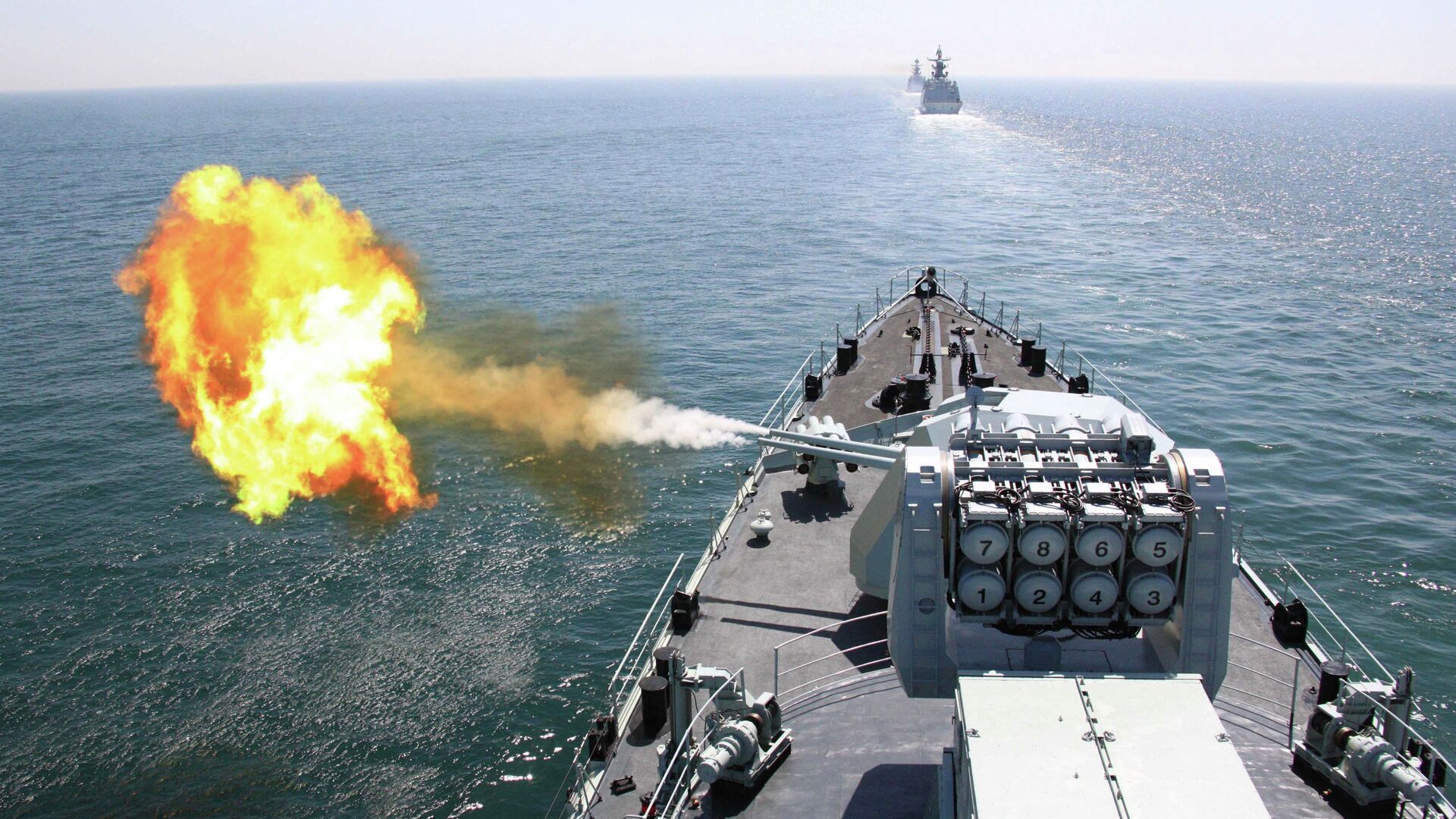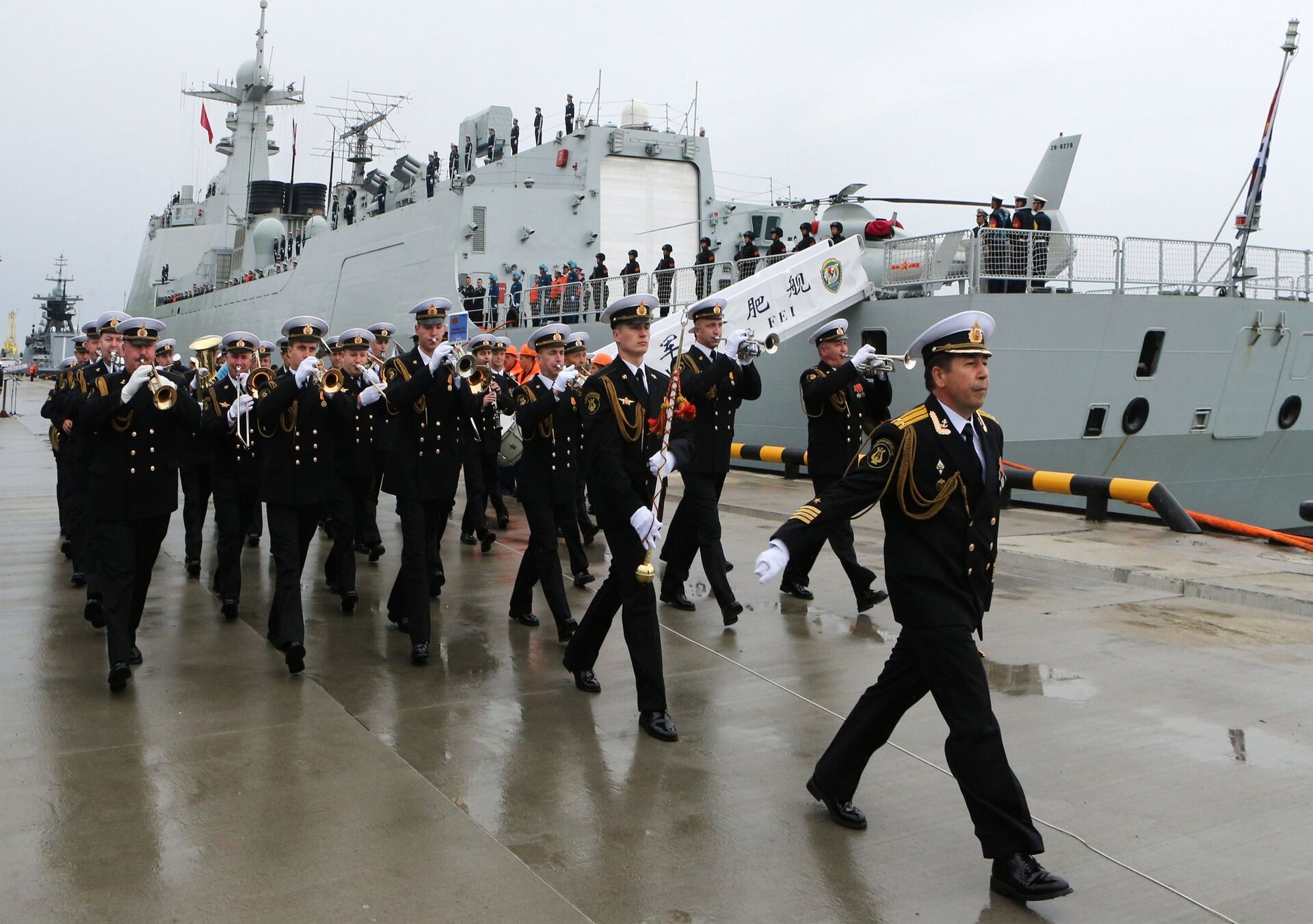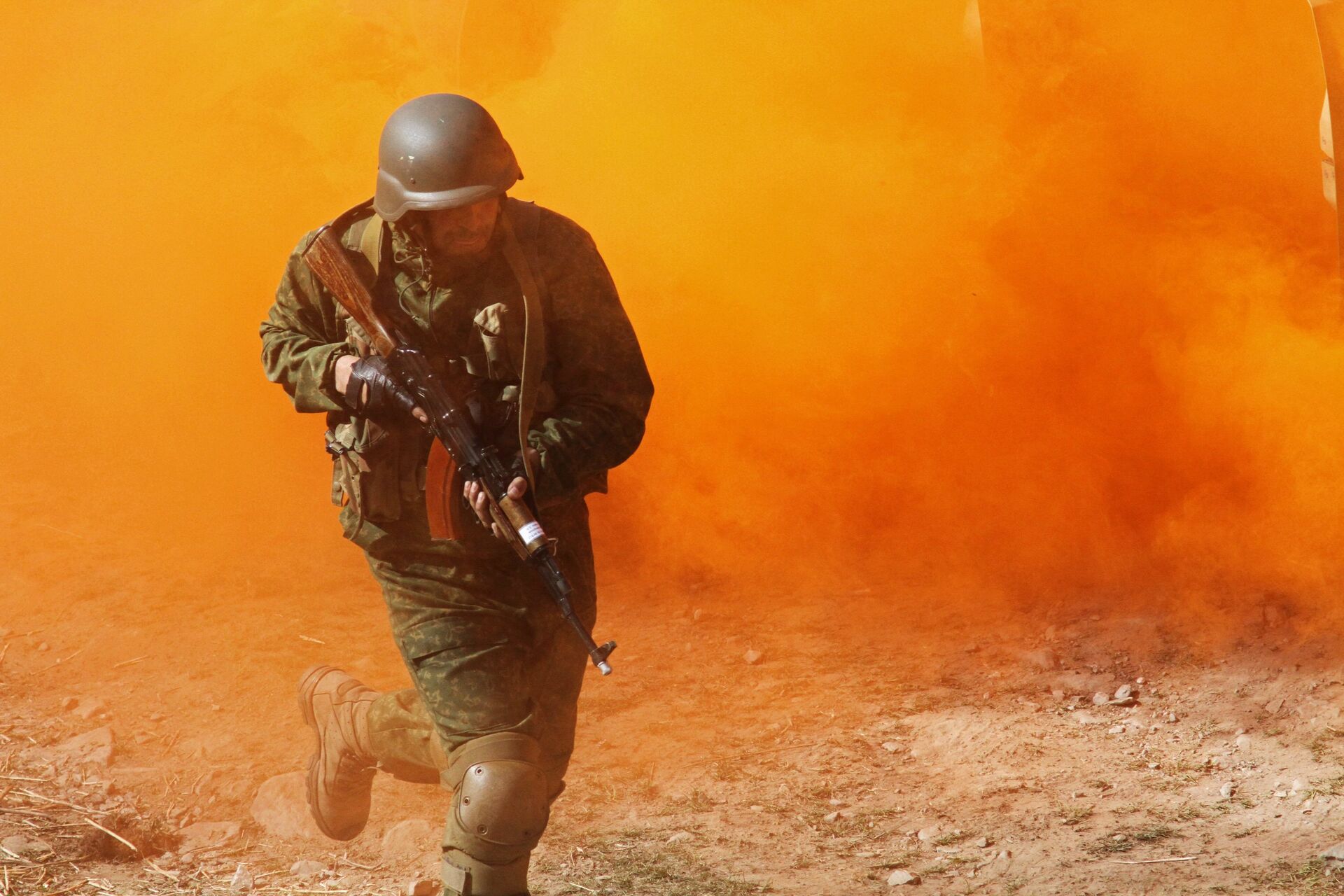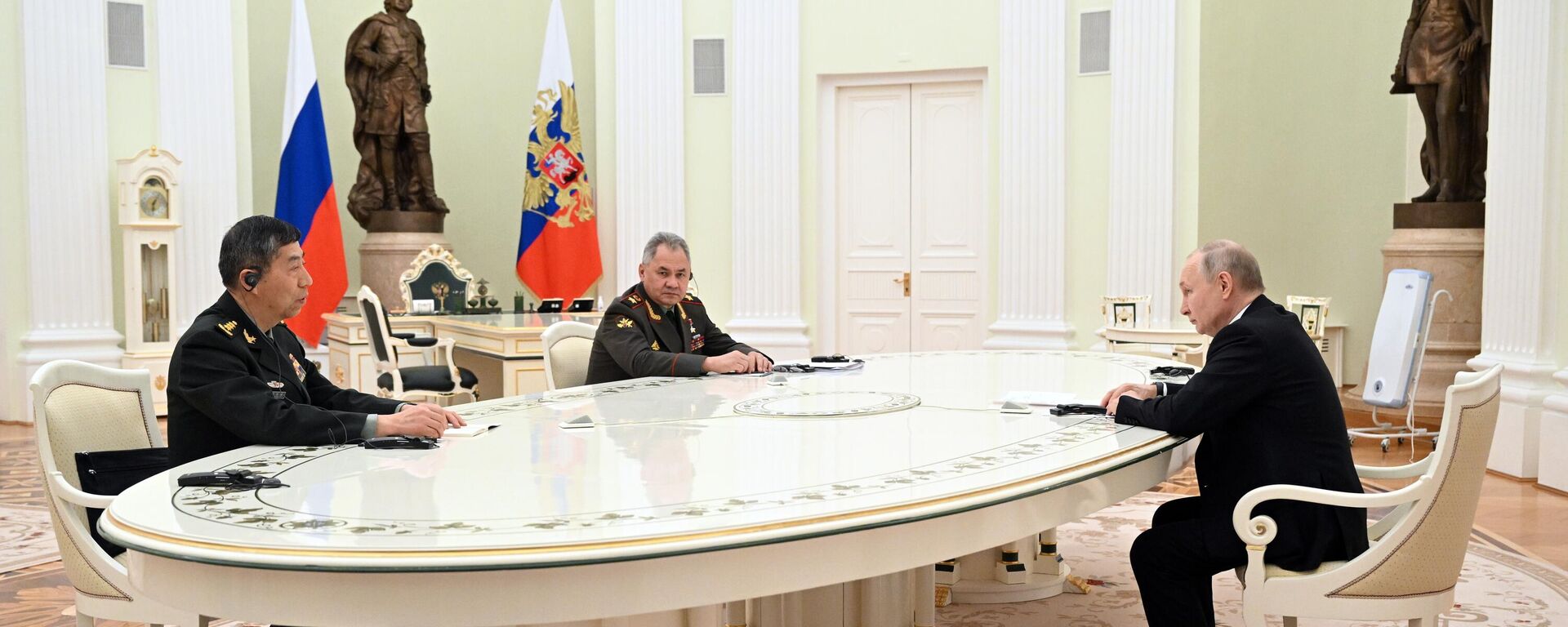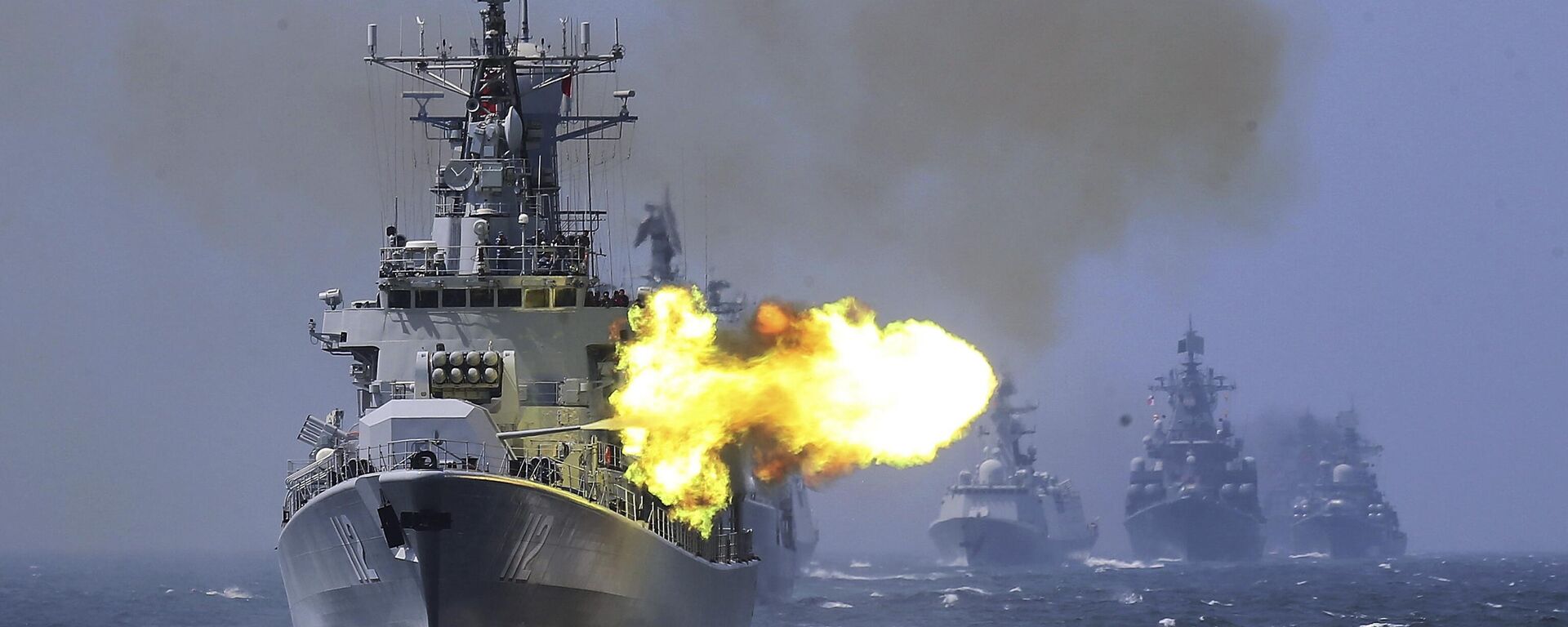https://sputnikglobe.com/20230417/russo-chinese-military-cooperation-to-ensure-world-peace-1109597106.html
Russo-Chinese Military Cooperation to Ensure World Peace
Russo-Chinese Military Cooperation to Ensure World Peace
Sputnik International
China's Minister of Defense Li Shangfu highlighted that Russo-Chinese relationship goes beyond the Cold War-era military and political alliances during his meeting with President Vladimir Putin and Defense Minister Sergey Shoigu.
2023-04-17T16:15+0000
2023-04-17T16:15+0000
2023-04-17T16:23+0000
military
opinion
us
central asia
pivot to asia
asia-pacific region
europe
nato
vladimir putin
ukraine
https://cdn1.img.sputnikglobe.com/img/102156/66/1021566611_0:156:4000:2406_1920x0_80_0_0_09923a85a06a0c5c777bcee3864ef488.jpg
"Chinese Defense Minister Li Shangfu's visit to Russia is an important event following President Xi Jinping's visit to Russia, and one of the biggest events in diplomatic relations between China and Russia this year," Zhou Rong, a senior analyst at the Chongyang Institute for Financial Studies at Renmin University of China, told Sputnik. "With US-led NATO under heavy pressure on Russia in Europe and on China in Asia, Moscow and Beijing need mutual support and a high degree of trust in military cooperation. Russian-Chinese cooperation will help prevent regional wars and conflicts."It is hardly a coincidence that Li Shangfu went to Russia on the heels of a state visit by Chinese Chairman Xi Jinping, who spent three days in Moscow in his first international trip since his re-election in the 2023 National People's Congress, according to Sergey Sanakoev, president of the Asia-Pacific Research Center and RIAC member.Likewise, it is no accident that on the eve of Li's arrival in Moscow, the Russian Pacific Fleet was placed on high alert for snap drills involving 25,000 troops, 167 warships and support vessels, including 12 submarines, as well as aircraft and helicopters, Sanakoev continued, stressing that the events are clearly related to each other.Having assumed the position of China's minister of national defense, Li Shangfu made his first trip to Russia, where he met with President Vladimir Putin and Defense Minister Sergey Shoigu. Li specified that he chose Russia "to emphasize the special nature and strategic significance of our bilateral relations." The Chinese minister stressed that relations between Moscow and Beijing are based on the principles of non-alignment, non-confrontation, and are not aimed at third parties, thus standing in contrast with NATO and other Western-led military blocs and political alliances. As per Li, Russo-Chinese relations "have already entered a new era."Two Phases of Russo-Chinese Military CooperationThe first phase of Russo-Chinese military-technical cooperation goes back to 1949, when the USSR and the People's Republic of China (PRC) established official military ties.During the first phase of the Sino-Soviet military-technical cooperation, Moscow dispatched 5,250 military advisers and specialists to the PRC, while 1,578 Chinese military personnel were trained in universities supervised by the Soviet Ministry of Defense.However, this cooperation was virtually suspended in 1969 due to ideological and political differences between the two Communist countries. After a 20-year pause, a second phase of the military-technical technical collaboration between Moscow and Beijing started in 1990. Based on the provisions of the intergovernmental agreement on military-technical cooperation (signed on November 24, 1992) and the memorandum of understanding between the governments of Russia and China (inked on December 18, 1992), Russian weapons sales to China burgeoned through the early 2000s.According to some estimates, China purchased more than 83% of its arms imports from Russia between 1990 and 2005. Those arms included, in particular, Russia's Sukhoi Su-27 and Su-30 fighters, Kilo-class diesel-powered submarines ,and Sovremenny-class (Type 956) destroyers.In addition, China acquired short and medium-range air defense systems, including the Tor, Buk, and Tunguska. Furthermore, in 2010, Russia completed a contract to supply China with 15 battalions of S-300 anti-aircraft missile systems.Even though the Chinese have themselves mastered jet production, they nonetheless turned to Russia in 2013-2015 to buy 24 Sukhoi Su-35 fighters. China became the first foreign buyer of the state-of-the-art jets.To cap it off, Russia also supplied two S-400 Triumph air defense regimental sets consisting of two divisions of launch devices, radiolocation stations, energy and service equipment, spare parts, and instruments to the People's Republic by January 2020.Joint Drills, Patrols, and CompetitionsRussia-China military cooperation has not been limited to the procurement of weapons: it has also seen army and naval drills as well as joint patrols, which have grown in frequency over time.Regular Russo-Chinese bilateral and multilateral military exercises started in 2003. On August 6-12, 2003, the armed forces of China, Kazakhstan, Kyrgyzstan, Russia, and Tajikistan staged a joint anti-terror exercise codenamed Coalition-2003 in Kazakhstan's border city of Ucharal and Ili, China's Xinjiang Uygur Autonomous Region.In 2005, Moscow and Beijing held their first bilateral anti-terror exercise, dubbed "Peace Mission" 2005, which took place in Russia's far eastern city of Vladivostok, and later moved to China’s Shandong Peninsula. The drills involved a staggering 8,000 Chinese troops and 2,000 Russian soldiers, who conducted both land and amphibious maneuvers.In subsequent years, the geography of Russo-Chinese drills has considerably expanded, going beyond the Asia-Pacific region: on September 18, 2009, a China-Russia naval drills were held in the western waters of the Gulf of Aden, a deepwater gulf in the Indian Ocean between Yemen to the north, the Arabian Sea to the east, Djibouti to the west, and the Guardafui Channel, Socotra, and Somalia to the south. Over the past several years, the two countries have conducted exercises near the South African coast as well as in the Mediterranean Sea. In July 2017, the Russian and Chinese navies carried out drills in the Baltic Sea, which included joint anti-submarine, anti-aircraft, and anti-ship defense.In 2022, both were seen jointly patrolling the Pacific Ocean, while most recently, in March 2023, the Russian, Chinese, and Iranian navies conducted exercises in the Gulf of Oman in the northwest of the Arabian Sea within the framework of the Marine Security Belt-2023. All in all, China and Russia have held roughly 80 joint military drills over the past 20 years.Russo-China Rapprochement Has Accelerated Since 2014According to international observers, the increase in the number of joint military drills largely came after 2014, which saw an illegitimate coup in Kiev, backed by the US. Approximately at the same time, the Barack Obama administration started to implement its "Pivot to Asia" aimed at regional isolation and containment of the People's Republic of China.In addition, the Russian scholar referred to the "special relations" between Moscow and Beijing, which started to emerge after Xi came to power as the chairman of the Central Military Commission (CMC) in 2012."As you know, exactly 10 years ago, Xi's first visit was to Russia, after he was elected as the chairman," Sanakoev noted. "And in fact, at that time, a very warm friendship began between him and President Putin, because both are also supreme commanders. Therefore, the [military-technical] cooperation increased; there were more and more joint exercises. However, this strategic partnership was by no means directed against any country or even against any military bloc, such as NATO."The Russian scholar underscored that Moscow and Beijing's relations have "outgrown" the very concept of a "military bloc." He quoted Minister of National Defense Li Shangfu's notion that the Russo-Chinese relationship goes beyond the Cold War-era military and political alliances."[Russo-Chinese] relations are much more effective in terms of military-technical cooperation," Sanakoev pointed out. "Since 2018, when Chinese leader Xi Jinping noted on the eve of the G20 summit in Hangzhou that Russia and China stand back to back, protecting the sovereign interests of our states, we have been formulating that we are closely cooperating in order to come to each other's rescue if someone from the outside pursues an aggressive policy in our direction, or if there is some kind of armed attack on our territories."The close Russo-Chinese cooperation has taken on a new significance as the US is fanning the flames of the Ukraine conflict, expanding NATO in Europe and AUKUS in the Asia-Pacific, as per the scholar. The assertiveness of the US and NATO is facilitating the Russo-Chinese rapprochement, Sanakoev stressed.
https://sputnikglobe.com/20230416/putin-holds-working-meeting-with-chinese-defense-minister-1109579595.html
https://sputnikglobe.com/20230127/time--and-combat-tested-why-china-holds-russias-sukhoi-su-35-fighters-in-high-regard-1106760824.html
https://sputnikglobe.com/20230330/russia-china-iran-naval-drills-make-positive-contribution-to-maritime-security-beijing-says-1108945961.html
https://sputnikglobe.com/20230223/south-africas-military-drills-with-russia-china-crucial-in-face-of-foreign-pressure-expert-says-1107672035.html
https://sputnikglobe.com/20230222/how-russo-chinese-strategic-cooperation-may-bring-us-forever-wars-to-end-1107713826.html
central asia
ukraine
russia
china
Sputnik International
feedback@sputniknews.com
+74956456601
MIA „Rossiya Segodnya“
2023
News
en_EN
Sputnik International
feedback@sputniknews.com
+74956456601
MIA „Rossiya Segodnya“
Sputnik International
feedback@sputniknews.com
+74956456601
MIA „Rossiya Segodnya“
russia-china cooperation, russia-china military-technical cooperation, russian arms sales to china, russia-china joint drills, russia-china joint patrols, xi jinping's visit to russia, chinese defense minister li shangfu, li shangfu visit to russia, li shangfu meeting with vladimir putin and sergey shoigu, us proxy war in ukraine, nato expansion
russia-china cooperation, russia-china military-technical cooperation, russian arms sales to china, russia-china joint drills, russia-china joint patrols, xi jinping's visit to russia, chinese defense minister li shangfu, li shangfu visit to russia, li shangfu meeting with vladimir putin and sergey shoigu, us proxy war in ukraine, nato expansion
"
Chinese Defense Minister Li Shangfu's visit to Russia is an important event following President Xi Jinping's visit to Russia, and one of the biggest events in diplomatic relations between China and Russia this year," Zhou Rong, a senior analyst at the Chongyang Institute for Financial Studies at Renmin University of China, told Sputnik. "With US-led NATO under heavy pressure on Russia in Europe and on China in Asia, Moscow and Beijing need mutual support and a high degree of trust in military cooperation. Russian-Chinese cooperation will help prevent regional wars and conflicts."
It is hardly a coincidence that Li Shangfu went to Russia on the heels of a state visit by Chinese Chairman Xi Jinping, who spent three days in Moscow in his first international trip since his re-election in the 2023 National People's Congress, according to Sergey Sanakoev, president of the Asia-Pacific Research Center and RIAC member.
Likewise, it is no accident that on the eve of Li's arrival in Moscow, the Russian Pacific Fleet was placed on high alert for snap drills involving 25,000 troops, 167 warships and support vessels, including 12 submarines, as well as aircraft and helicopters, Sanakoev continued, stressing that the events are clearly related to each other.
"It is clear that one is related to the other," the Russian scholar said. "And, of course, we are talking about close cooperation. And if so, then we understand that there is a special level of interaction and a demonstration to the world that we do not intend to tolerate the aggression that the United States is displaying today, that we have all the necessary forces to restrain the aggressor and force it to peace."
Having assumed the position of China's minister of national defense, Li Shangfu made his first trip to Russia, where he met with President Vladimir Putin and Defense Minister Sergey Shoigu. Li specified that he chose Russia "to emphasize the special nature and strategic significance of our bilateral relations." The Chinese minister stressed that relations between Moscow and Beijing are based on the principles of non-alignment, non-confrontation, and are not aimed at third parties, thus standing in contrast with NATO and other Western-led military blocs and political alliances. As per Li, Russo-Chinese relations "have already entered a new era."
"The last 10 years have been a new stage in relations [in Russo-Chinese military-technical cooperation - Sputnik]," said Sanakoev. "It started at the end of the 1990s, so we have been building up our military-technical cooperation for a little over a quarter of a century. And, basically, we are talking about the supply of our weapons to China, including technology. We have sufficiently raised the level of technical equipment of the People's Liberation Army of China as our strategic partner and good neighbor. And, most likely, I would link this new stage with the agreement that was signed in 2001 on good neighborliness, friendship and cooperation. And over the years, our cooperation has only grown."
Two Phases of Russo-Chinese Military Cooperation
The first phase of Russo-Chinese military-technical cooperation goes back to 1949, when the USSR and the People's Republic of China (PRC) established official military ties.
Between 1949 and 1969, the Soviet Union provided the PRC with $4.1 billion worth of weapons and military equipment. In particular, in 1951, the PRC received 700 MiG-15 fighter jets and 150 Tu-2 light bombers from the USSR and effectively tripled the size of China’s Air Force fleet. In addition, between 1949 and 1962, Moscow transferred 650 licenses for the production of weapons and military equipment to Beijing free of charge. According to military observers, that helped China kick off the production of the J-4, its first indigenous combat aircraft modeled on the Soviet MiG-17, by 1956.
During the first phase of the Sino-Soviet military-technical cooperation, Moscow dispatched 5,250 military advisers and specialists to the PRC, while 1,578 Chinese military personnel were trained in universities supervised by the Soviet Ministry of Defense.
However, this cooperation was virtually suspended in 1969 due to ideological and political differences between the two Communist countries. After a 20-year pause, a second phase of the military-technical technical collaboration between Moscow and Beijing started in 1990. Based on the provisions of the intergovernmental agreement on military-technical cooperation (signed on November 24, 1992) and the memorandum of understanding between the governments of Russia and China (inked on December 18, 1992), Russian weapons sales to China burgeoned through the early 2000s.
According to some estimates, China purchased more than 83% of its arms imports from Russia between 1990 and 2005. Those arms included, in particular, Russia's Sukhoi Su-27 and Su-30 fighters, Kilo-class diesel-powered submarines ,and Sovremenny-class (Type 956) destroyers.
During 2007-2021, China’s arms imports from Russia somewhat declined, as the People's Republic shifted largely to local production, assisted by Russian specialists. For instance, Russian designers participated in projects to build the Chinese J-10 and JF-17 fighters, as well as the L-15 training aircraft. Russia also facilitated licensed production of the Su-27SK codenamed J-11 in the city of Shenyang, China beginning in 1998. The documentation provided by Russia helped the Chinese manufacturers create the J-15 carrier-based fighter.
In addition, China acquired short and medium-range air defense systems, including the Tor, Buk, and Tunguska. Furthermore, in 2010, Russia completed a contract to supply China with 15 battalions of S-300 anti-aircraft missile systems.
Even though the Chinese have themselves mastered jet production, they nonetheless turned to Russia in 2013-2015 to buy
24 Sukhoi Su-35 fighters. China became
the first foreign buyer of the state-of-the-art jets.

27 January 2023, 13:16 GMT
To cap it off, Russia also supplied two S-400 Triumph air defense regimental sets consisting of two divisions of launch devices, radiolocation stations, energy and service equipment, spare parts, and instruments to the People's Republic by January 2020.
"Some Western countries who are 'worried' about China's increased national defense budget, should bear in mind that China's GDP is 77% of that of the US, and China's defense budget is only a quarter of that of the US. China's defense budget is maintained at 1-1.5% of GDP, the lowest share among the world's leading major countries," Zhou Rong remarked. "In the future, China will continue to increase its defense budget, and the rate of increase will depend on China's responsibility and mission to maintain world peace, as well as external threats and challenges that China will face."
Joint Drills, Patrols, and Competitions
Russia-China military cooperation has not been limited to the procurement of weapons: it has also seen army and naval drills as well as joint patrols, which have grown in frequency over time.
Regular Russo-Chinese bilateral and multilateral military exercises started in 2003. On August 6-12, 2003, the armed forces of China, Kazakhstan, Kyrgyzstan, Russia, and Tajikistan staged a joint anti-terror exercise codenamed Coalition-2003 in Kazakhstan's border city of Ucharal and Ili, China's Xinjiang Uygur Autonomous Region.
In 2005, Moscow and Beijing held their first bilateral anti-terror exercise, dubbed "Peace Mission" 2005, which took place in Russia's far eastern city of Vladivostok, and later moved to China’s Shandong Peninsula. The drills involved a staggering 8,000 Chinese troops and 2,000 Russian soldiers, who conducted both land and amphibious maneuvers.
In subsequent years, the geography of Russo-Chinese drills has considerably expanded, going beyond the Asia-Pacific region: on September 18, 2009, a China-Russia naval drills were held in the western waters of the Gulf of Aden, a deepwater gulf in the Indian Ocean between Yemen to the north, the Arabian Sea to the east, Djibouti to the west, and the Guardafui Channel, Socotra, and Somalia to the south. Over the past several years, the two countries have conducted exercises near the South African coast as well as in the Mediterranean Sea. In July 2017, the Russian and Chinese navies carried out drills in the Baltic Sea, which included joint anti-submarine, anti-aircraft, and anti-ship defense.
In 2022, both were seen jointly patrolling the Pacific Ocean, while most recently, in March 2023,
the Russian, Chinese, and Iranian navies conducted exercises in the Gulf of Oman in the northwest of the Arabian Sea within the framework of the Marine Security Belt-2023. All in all, China and Russia have held roughly 80 joint military drills over the past 20 years.
"Now military exchanges between China and Russia have become common practice," Zhou Rong noted. "Moreover, the interaction takes place at a high level; the parties are in constant contact in terms of strategic communication. In addition, our countries conduct joint exercises and develop exchanges between military scientific circles. It should be said that the strategic partnership between China and Russia is also deepening in the military field, which is very important."
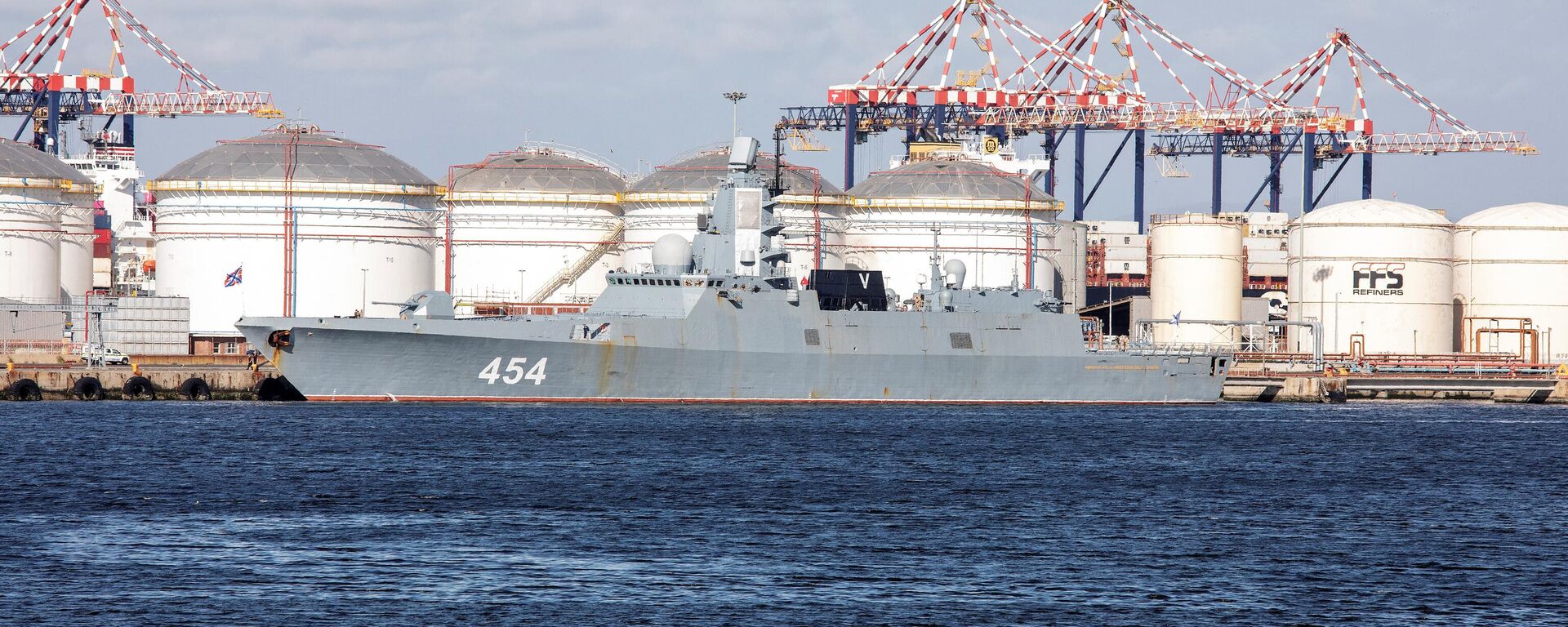
23 February 2023, 08:34 GMT
Russo-China Rapprochement Has Accelerated Since 2014
According to international observers, the increase in the number of joint military drills largely came after 2014, which saw an illegitimate coup in Kiev, backed by the US. Approximately at the same time, the Barack Obama administration started to implement its "Pivot to Asia" aimed at regional isolation and containment of the People's Republic of China.
"In recent years, the rhetoric of the United States of America has changed so much that we see how they directly say that Russia is the enemy, China is the enemy," Sanakoev said. "This is reflected in their doctrines. Therefore, naturally, [Russia and China] are beginning to think about closer cooperation, including such forms as joint patrolling of our borders. And we certainly succeeded in this, and we have very good interaction."
In addition, the Russian scholar referred to the "special relations" between Moscow and Beijing, which started to emerge after Xi came to power as the chairman of the Central Military Commission (CMC) in 2012.
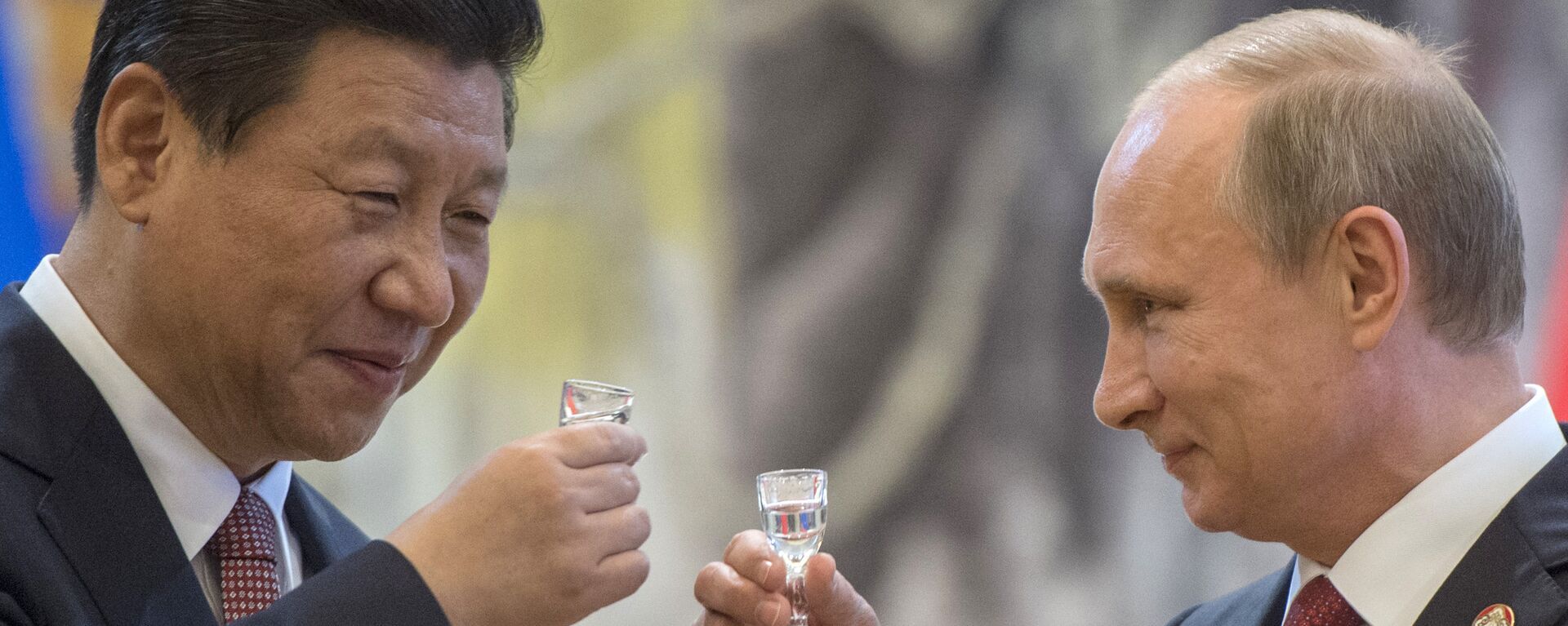
22 February 2023, 17:29 GMT
"As you know, exactly 10 years ago, Xi's first visit was to Russia, after he was elected as the chairman," Sanakoev noted. "And in fact, at that time, a very warm friendship began between him and President Putin, because both are also supreme commanders. Therefore, the [military-technical] cooperation increased; there were more and more joint exercises. However, this strategic partnership was by no means directed against any country or even against any military bloc, such as NATO."
The Russian scholar underscored that Moscow and Beijing's relations have "outgrown" the very concept of a "military bloc." He quoted Minister of National Defense Li Shangfu's notion that the Russo-Chinese relationship goes beyond the Cold War-era military and political alliances.
"[Russo-Chinese] relations are much more effective in terms of military-technical cooperation," Sanakoev pointed out. "Since 2018, when Chinese leader Xi Jinping noted on the eve of the G20 summit in Hangzhou that Russia and China stand back to back, protecting the sovereign interests of our states, we have been formulating that we are closely cooperating in order to come to each other's rescue if someone from the outside pursues an aggressive policy in our direction, or if there is some kind of armed attack on our territories."
The close Russo-Chinese cooperation has taken on a new significance as the US is fanning the flames of the Ukraine conflict, expanding NATO in Europe and AUKUS in the Asia-Pacific, as per the scholar. The assertiveness of the US and NATO is facilitating the Russo-Chinese rapprochement, Sanakoev stressed.
"China and Russia are indispensable elements in ensuring world peace, and given their membership in the Shanghai Cooperation Organization (SCO) and participation in the BRICS format, they play a special role in maintaining regional stability," Zhou Rong echoed. "At the same time, it should be emphasized that, despite the high degree of mutual trust between the military of the two countries, China and Russia have not formed a military alliance and do not intend to move towards its creation."
